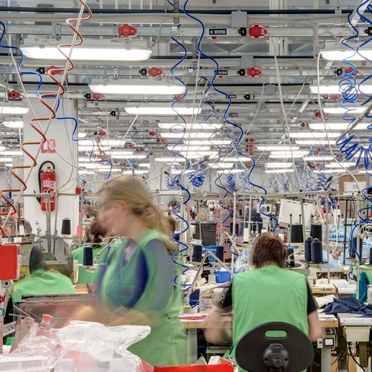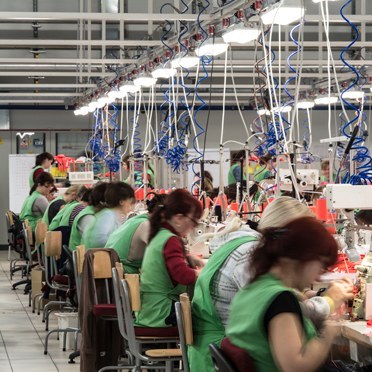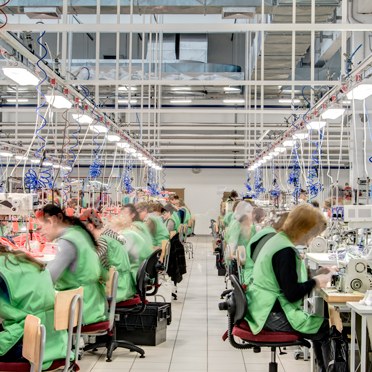Thorn’s industrial collection catches the eye with 78% energy savings
- Lamp efficacy
Lamp efficacy
Ensuring the lamp efficiently converts electricity into light (lm/W).
- Ballast classification
Ballast classification
Controlling the electricity supply to the lamp (Energy Efficiency Index).
- Luminaire distribution
Luminaire distribution
Controlling light emission using optics which bend and shape the light to the correct location.
- System efficacy
System efficacy
Combining optical and thermal control within the luminaire (luminaire lm/W).
- Presence/absence detection
Presence/absence detection
Presence: Lights automatically turn on/off with movement. Absence: Lights automatically turn off and must be manually switched on.
- Daylight detection
Daylight detection
Artificial lighting which responds to the natural light conditions.
- Constant illuminance
Constant illuminance
A function designed to produce correct light levels for the duration of the maintenance period.
- Task-scene setting
Task-scene setting
Allowing the user to set scenes and adapt the lighting to different tasks.
- Timed off
Timed off
Automatic cut-off can be installed to turn all lights off during unoccupied hours.
- Task lighting
Task lighting
Lighting task areas with the correct amount of light.
- Zoning of lighting
Zoning of lighting
Lighting is zoned according to area use.
- Maintenance schedule
Maintenance schedule
Maintenance must be performed in response to product age, performance and environment.
- Waste light
Waste light
Eliminating waste light which does not hit the intended target.
- Reflectance
Reflectance
Taking advantage of light which is reflected from the surface within the space.
- Visible smart metering
Visible smart metering
Results of actions can be quickly seen as increased or decreased energy use to encourage responsible energy consumption.
The Challenge
Spiralling energy costs and maintenance bills prompted Italian fashion brand Calzedonia to look at replacing the old and inefficient lighting installation at its production facilities in the Croatian town of Varaždin. Run by Comprom PLUS, a member of the Calzedonia group, the factory covers almost 6000 square metres and manufactures a wide range of designer swimwear and lingerie.
Calzedonia applied for European funding to support the initiative and enlisted the help of long-standing partner Elektroinstalateri d.o.o., a group of electricians who pride themselves on delivering efficient solutions that meet the specific needs of their clients. In the case of the Varaždin factory, achieving real cost savings was one of the main priorities, as significant improvements in energy efficiency were required to help the project qualify for official financial support.
However, the new installation also needed to cope with the testing environmental conditions found in the production area. Fine fabric particles can enter the fittings and negatively affect lighting performance over time, which means that the luminaires have to be cleaned at regular intervals. As a result, ensuring reliable protection and lowering maintenance costs were also important considerations.
Denis Rodinger, Elektroinstalateri project manager, explained: “Project Calzedonia has been in the preparation phase for the last year. We tested several products to find just the right solution. ForceLED from Thorn came out on top, achieving the best results in terms of performance and initial investment.”
The Solution
Denis Rodinger selected ForceLED from Thorn to replace the existing 2x58W fluorescent waterproof fittings. The IP67 protection rating of ForceLED ensures reliable protection against dust and moisture, stopping fabric particles from entering the luminaire and enabling longer maintenance cycles by reducing the need for cleaning. ForceLED LED provides a high-quality and low-energy output of 6000 lumens, incorporating highly efficient LEDs that deliver more than 100 lumens per watt.
Lighing controls were then added to the solution to help the client enjoy maximum benefits. Vlatka Đurić, Brand Manager from Thorn Lighting, said: “ForceLED has a series of controls options. Here we have incorporated lighting controls that dim up and down according to the amount of daylight entering the factory through the skylights. This means that the luminaires are operating at full power for fewer hours each day, as Calzedonia make the most of the natural light available.”
The Results
ForceLED is now achieving impressive energy savings of 78% in the Varaždin factory, while at the same time significantly reducing both maintenance and replacement costs. The Lighting Energy Numeric Indicator (LENI) has been cut from 46.89 to an impressive 10.28. As well as boosting energy efficiency, the new solution will save 89 tons of carbon dioxide each year.
Investor Bruno Prapotnik is delighted with the results: “This is an excellent solution for us. We save because the lighting is more efficient and we have more output and better coverage from fewer luminaires – plus we know that the products are sealed against any dust and dirt. In addition, our workers now benefit from improved lighting quality.”
“The lighting solution was implemented without any problems,” confirmed Denis Rodinger. “Complete mounting had to be done at weekends to avoid stopping production – and in total it took just four days for the whole installation. The end user is very happy with the work, laying the foundations for future cooperation in industry applications.”
3 Steps to Saving Energy
Taken from Thorn’s 15 ways to save energy, the following three factors have really helped minimise energy consumption at the Calzedonia factory:
• Lamp efficacy
ForceLED features advanced LED technology that needs relatively little power to emit a large amount of light. This helps significantly lower energy consumption.
• Light distribution
The ForceLED diffuser has linear prisms that guarantee maximum efficiency by producing a wide symmetrical distribution. This benefit was particularly important in the Calzedonia project, where luminaires are mounted 1.5 metres above the working plane. The uniform light distribution illuminates the task area without causing glare, reducing the need for additional lighting and therefore cutting the total number of luminaires required.
• Daylight
The Calzedonia project was part of a European funding initiative aimed at energy efficient projects. Additional points were secured by incorporating lighting controls that cleverly respond to the levels of natural daylight coming through the skylights. The luminaires have been programmed to dim down when there is enough natural light on the task area, making a major contribution to the overall energy savings.
Key facts: Calzedonia Factory, Croatia
| Energy savings | 78% |
| CO2 savings89 | 89 tons per year |
| Lighting Energy Numerical Indicator (LENI) | Reduced from 46.89 to 10.28 |



